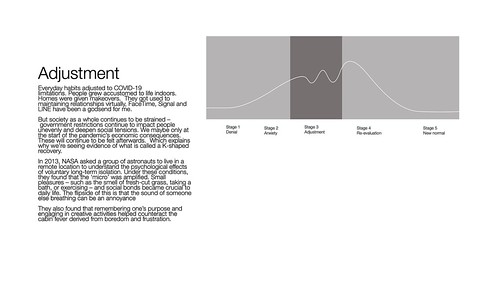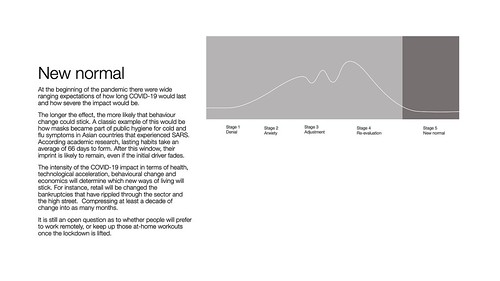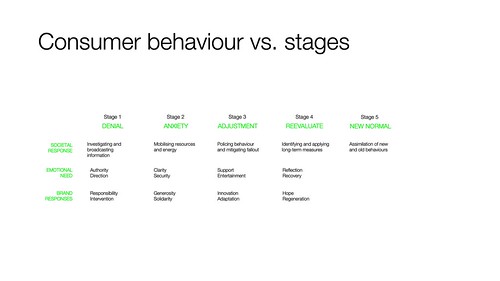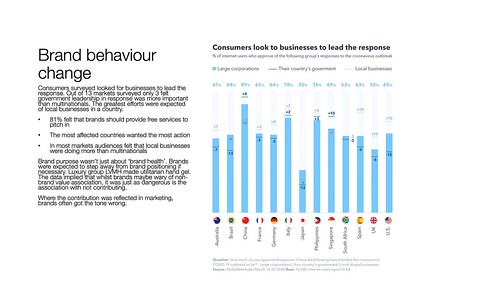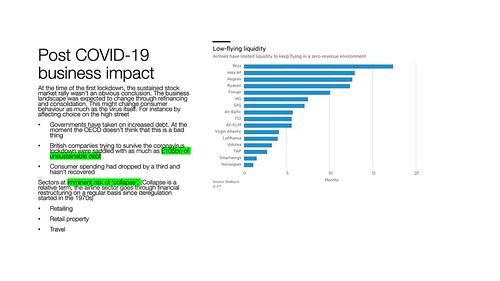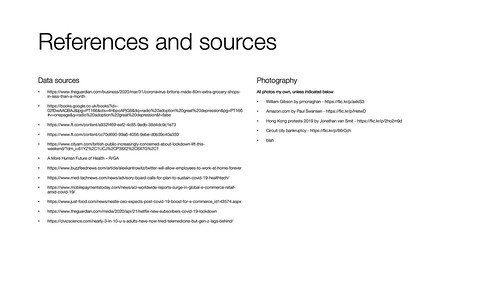4 minutes estimated reading time
Looking back at 2020 was based on desk research I undertook at the end of March through to the beginning of May this year for 90TEN; with a healthy dollop of hindsight added.
The first thing that I tried to make sense of was all the noise from experts who claimed that everything was going to change. Clearly that wasn’t going to be the case. But what would elements would be most affected? I narrowed it down to a combination of three factors:
- Demand side and supply side economic change
- Accelerating trends
- Behavioural change
Where you have an intersection of all three, then you are more likely to have lasting change.
Behavioural change on its own won’t work. When we had the Spanish flu, there was a similar level of masking and social separation. But what followed was the hedonism of the roaring 20s. But all three factors together would act as a push-and-pull on sustained behaviour change.
Thinking specifically about acceleration, we saw a number of things happen.
- Changes in sectors and practices that would have taken years have taken months. Such as the adoption of remote working practices
- Things that were on the edge suddenly became mainstream, like mask wearing that was previously only popular in east asian countries like Korea, Taiwan, Hong Kong and Japan
The rise of e-commerce and food delivery was a classic edge case to mainstream move.
Looking back 2020, one of the topics is the speed of change in circumstances and the relative lack of change in human behaviour. One academic claimed that it revealed what really mattered to a population. Although this misses out that the competency of a government as a key determining factor.
Canvas8 presented a model of human behaviour during an epidemic, which I shared in looking back at 2020. This shaped a key part of my thinking around human behaviour.
Like the grief process, the pandemic human behaviour model starts with denial.
And then anxiety…
Adjustment is how people have adapted to the circumstances. Society as a whole is still under strain.
Life is reconsidered moving forward, a classic example of this would be the Wuhan EDM pool party held in the autumn.
The new normal where COVID-19 is now under control and will have shaped future consumer behaviour.
Canvas8 also mapped out likely consumer behaviour against the stages.
Consumers had a clear view of what they wanted from brands. Brands often struggled to match the expectations of consumers. Dettol’s UK marketing efforts being an exemplary example of how to get it wrong. Looking back at 2020, we had the opportunity to do fantastic marketing work utilising digital and TV platforms, but very little of that opportunity was utilised.
A couple of organisations deserve for their efforts to be highlighted. My former colleagues at LONDON Advertising used their own marketing during the middle of the crisis to demonstrate the power of marketing. Secondly, the IPA ran a sustained campaign in the FT promoting the power of advertising to the c-suite.
The economic factors that will be a driver in societal change, made up the third factor alongside behavioural aspects and acceleration of existing trends.
The initial economic forecasts were very negative which drove a ‘correction’ in the stock markets.
Past trends indicate that these kind of crises cause an economic decline that countries bounce back from. However a lot of the change happening is non-COVID related or only tangentially related like China’s escalating trade sanctions on Australia.
Post COVID-19 economic impact is like dropping industry sectors in a time machine. The kind of change that would normally have taken years to run its course has happened in months. What is more worrying is the amount of unsustainable debt that has been taken on board by businesses across sectors. Over time this will benefit larger established businesses over smaller, or newer ones.
I put in an extra section into looking back at 2020 about the young because the insights challenge many of marketers holy cows in terms of views on younger members of society.
Telemedicine attitudes and usage shows that the heuristic of young people being technology adopters doesn’t hold up. Which is usually presumed in sentiment around digital natives.
The resisters shatters a stereotype of young people being progressive, purpose driven people. And they are media literate and media savvy by nature. Yet they are exhibiting behaviours that would be more in tune with older people with reactionary views.
I put in the links to the sources that I mention in the presentation. However I formed my views by looking at much more material. Just over a gigabyte of data sources that relate to COVID-19 which I went through is on Google Drive. Everything from consumer behaviour to economic data is available here. The looking back at 2020 presentation is available for download here. (More on issues related consumer behaviour here.)








